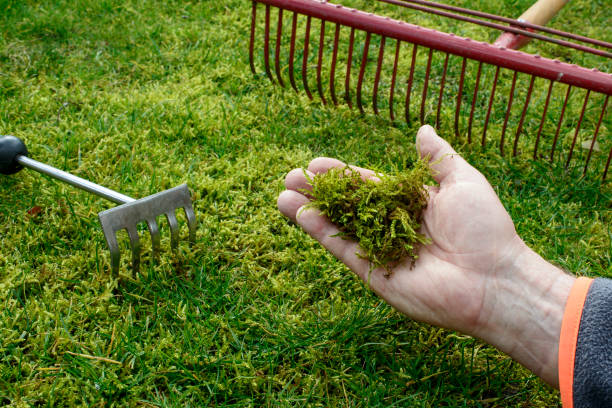Are you a homeowner who is struggling with moss on your lawn?
We understand the frustration of seeing your beautiful green lawn overtaken by patches of unsightly moss. Not only does it damage the look of your lawn, but it also weakens the grass by blocking essential nutrients and sunlight. The moss in your lawn indicates that it is unhealthy and needs attention. Moss thrives in damp, shady areas where the grass is not growing properly due to poor soil, lack of nutrients, improper mowing, or excessive watering. But don’t worry! You don’t have to live with this frustrating problem forever. In this article, we will guide you on how to get rid of moss in your lawn and prevent it from reoccurring. We will share some valuable insights, tips, and useful techniques that you can use to create a beautiful and thriving lawn.
Understanding Moss in Lawn
Moss on your lawn can be a frustrating sight to behold. However, it’s essential to understand the root cause before trying to eliminate it. It may not be demanded to remove the moss in some cases. Instead, addressing the factors that promote its growth is essential.
Poor Soil Quality
Soil quality is a crucial factor affecting your lawn’s overall health. When the soil is compacted, heavy, or lacks organic matter, it affects the ability of grass to grow. In such situations, moss can thrive because it doesn’t require the same conditions as grass. A soil test can help you establish your soil’s PH level and its required nutrients.
Lack of Sunlight
Without adequate exposure to the sun, the grass is vulnerable to moss growth, particularly in areas with limited sunlight. To prevent this problem from arising or continuing, try pruning trees and shrubs to let more light through their branches. As an additional safeguard against inadequate lighting conditions for your lawn, consider consulting a lawn care expert about selecting species of grass that can endure such circumstances more effectively.
Excessive Moisture
Overwatering your lawn and poor drainage can lead to excess moisture, promoting moss growth. Consider adjusting your sprinkler system or watering your lawn less frequently. Also, avoid watering your lawn at night, as it can lead to prolonged periods of moisture favorable to moss growth.
Weeds on the Lawn
Weeds in your lawn provide an excellent environment for moss growth. Weeds can fight for nutrients and water with grass, resulting in uneven lawns with barren areas.
Besides, weeds can contribute to soil compaction, making it difficult for grass to grow. Consider using natural weed killers to eliminate weeds in your lawn and avoid using chemicals that can also kill the grass.
How to Get Rid of Moss on Lawn
The first step in removing moss is removing it from the lawn. You can use either a hand rake or a power rake, also known as a dethatched, to remove the moss systematically. Raking before applying a moss killer helps expose the moss, making it easier for the moss killer to penetrate it. For best results, rake the moss thoroughly, and make sure you get all of it.
After raking, it’s essential to apply a good quality moss killer. Choose a safe moss killer for humans, pets, and plants. Make certain you buy a product that has been specially formulated for lawns. Moss killers contain active ingredients that kill the moss, making removing them easier. Once you purchase a moss killer, please read the instructions carefully, mix it as directed, and apply it to the affected area.
The following step is to water the lawn thoroughly. Watering is essential to ensure the moss killer goes deep into the soil, killing the moss roots. Water the lawn immediately after applying the moss killer and continue watering as usual. Depending on the mass killer’s strength, you may need to wait a few days before raking the dead moss out of the lawn. Be patient and let the moss killer do its work.
Another option is to change lawn care practices to control moss. For instance, moss tends to thrive in shaded areas with poor drainage. Lighten the lawn or prune any overhanging trees or shrubs to increase sunlight penetration. Aerating the lawn or adding organic matter such as compost can help improve drainage, leading to a healthy yard that is less likely to develop moss.
After the dead moss is removed from your lawn, it’s essential to inspect the area and determine a plan of action. With this step, you may decide that reseeding or removing the remaining residue is needed. Caring for your lawn requires routine mowing and fertilization, ensuring water can drain properly. These efforts will help preserve its beauty!
Prevent Moss from Coming Back
You’re not alone if you often see a layer of green fuzz covering your lawn. Moss is a common problem that can wreak havoc on your lawn’s appearance and overall health. While it may seem impossible to keep moss from returning, you can take a few simple steps to create an environment that makes it difficult to thrive.
Ensure you get adequate sunlight – Moss is often a consequence of inadequate sun exposure, so if bushes or trees obstruct your grass from receiving light, it’s time to take action. Consider trimming back branches and cutting down the tree (or at least pruning it significantly) to let in more sunshine. Additionally, do not plant plants that relish shadows close by, as they can impede sunlight penetration.
Remove Surface Debris – If you want a lush lawn filled with moss, ensure there are shaded and moist spots. Regularly clear away any surface debris like dead leaves or twigs using a leaf blower or rake – particularly during the fall when fallen foliage is abundant.
Choose the Right Grass Seed – Different grass types thrive under different climatic conditions, and some are more resistant to moss. Make sure you choose grass seeds most suited to your region and soil type. Moreover, once the grass is established, ensure it receives proper care; watering, fertilizing, and mowing can all help strengthen the grass and create an environment that is not conducive to moss growth.
Treat Moss Patches – Once you’ve cleared your lawn of moss, you can take a few preventive measures to mitigate its return. One effective solution is applying a moss killer designed to prevent moss from growing back. A common moss-killing agent is a ferrous sulfate, which can be bought from gardening stores. Follow the instructions carefully while applying, and ensure the product is safe for your grass and soil.
Aerate Your Lawn – Aerating your lawn allows oxygen, water, and nutrients to access the grassroots by removing soil blockages. This process improves the lawn’s ability to absorb nutrients, resulting in stronger and thicker grass that is less prone to moss growth.
Getting rid of moss on lawns requires patience and diligence. You must understand the root cause and take steps to eliminate it. Improving soil quality, promoting grass growth, and preventing moss from returning are the key steps to a healthy lawn. You can enjoy a moss-free lawn by following the advice in this blog post.

